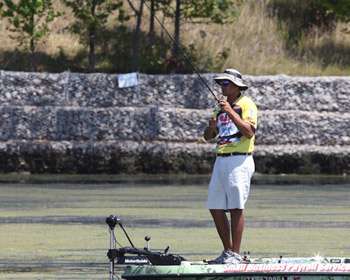
A trip to the local tackle retailer will reveal a plethora of color options in similar swirls, laminates, flecks and hues. It leaves one wondering if such subtle color differences really matter that much when it comes to catching bass.
Elite Series pro James Niggemeyer has developed a loose system to help simplify his color selection. "There are so many different color combinations on the market today, and I think that sometimes you can overcomplicate things by all the different colors that come our way," admits the Texan. "There are four colors that you're going to find in my box on any given lake in any situation — watermelon red, green pumpkin, junebug and black and blue.
Those four colors are going to fit just about any situation from coast to cast. Those four colors are going to cover all your conditions," explains Niggemeyer. That being said, under specific circumstances he believes that subtle color changes can put more fish in the boat. "I think that subtle color changes can sometimes really be overlooked, and I've noticed that in my own fishing," explains Niggemeyer.
"Take a watermelon tube in clear water for instance. In clear water that really is one of the most natural colors that you're going to want to reach for, but if you start adding some stain to the water, dipping the tails of the tube in chartreuse just to catch the bass' attention can be really effective." Niggemeyer utilizes subtle color changes in order to create a more visible offering to bass. "Doing something like adding red flake to a watermelon tube will give the bait a darker appearance and that darker silhouette will show up more in stained water," he claims. "I've even seen cases where a green pumpkin will out-fish a watermelon red because it created a darker profile.
The different hues make a difference in whether or not the fish can see the bait really well or not." Niggemeyer also uses subtle color changes depending on the forage that the bass are targeting. "If the fish are focusing on shad, then I'll use something that's more of a baitfish color. If there is more than three feet of visibility, you want to use more translucent colors and not so many opaque colors."
When fishing stained water, he opts for more visible solid colors and pays less attention to minor color changes. "The darker the water, the more opaque I want my color to be. As you start to get into stained and muddy water, you start to go from your green pumpkin into your junebug, red shad or black and blue," Niggemeyer explains.
When it comes to color selection for bedding bass, pinpointing just the right color is often a matter of trial and error. "One of the things that I've seen in my sight fishing over the years is that sometimes some of the natural colors are going to work well, but I've also seen where a primary color like white or an outlandish color like a pink or chartreuse will really get them fired up," allows Niggemeyer. "It seems like it's on an individual basis where you'll see a fish and you have to change shapes and colors and have a few different colors rigged up to find what that bass prefers."
Niggemeyer offers this piece of advice to anglers looking to expand the color spectrum. "There are definitely instances where subtle color changes make a big difference especially in clear water, but in general, those basic colors are probably going to catch just as many fish as the others."
(Provided by Z3 Media)




